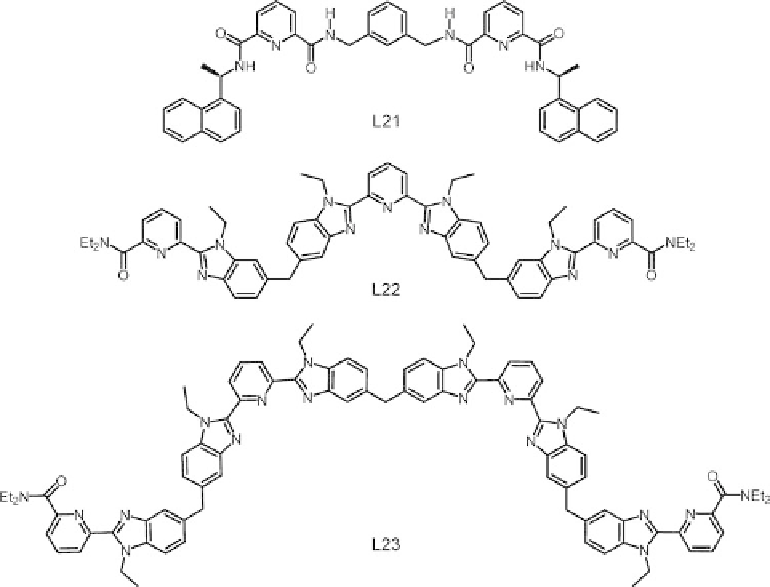Chemistry Reference
In-Depth Information
Scheme 6.5 Ligands for polynuclear helicates described in Section 6.2.6.
6.2.6.2 Tri- and Tetranuclear Triple-Stranded Helicates
The tritopic ligand L22 self-assembles with lanthanoid triflates in acetonitrile to produce
triple-stranded helicates [Ln
2
(L22)
3
]
6þ
and [Ln
3
(L22)
3
]
9þ
(Ln
La, Nd, Eu, Tb, Ho, Tm,
Lu) with stability constants which do not vary along the series, log
¼
b
23
26 and log
b
33
35 [86]. In the trinuclear helicates, the metal ions are embedded into two different coor-
dination sites, the two end N
6
O
3
cavities and the central N
9
cavity. This is perfectly
reflected in the
5
D
0
7
F
0
excitation spectra reported in Figure 6.13. They have been
measured under selective analysis of the high-energy components of the
5
D
0
!
7
F
1
transi-
tions which differ sufficiently in energy, as shown by the corresponding emission spectra
recorded under selective excitation of the
5
D
0
!
7
F
0
transitions. To avoid as much as pos-
sible energy transfer between the sites, the excitation wavelength has not been set exactly
on the maxima of the two components. At room temperature the energies of the two
5
D
0
!
7
F
0
transitions amount to 17 239 and 17 225 cm
1
, in reasonable agreement with
the observed values for [Eu
2
(L3)
3
]
6þ
,17236cm
1
and for [Eu
2
(L4)
3
]
6þ
, 17 232 cm
1
(cf.
Table 6.1). That is, the higher energy value corresponds to the N
9
chemical environment, a
fact substantiated by the much weaker emission from this site due to LMCT quenching.
Analysis of the ligand-field splitting of the
7
F
1
level in terms of pseudo-
D
3
symmetry at
room temperature and 10K (data in parentheses) gives D
E
(A
2
E)
¼
100 (75) and 123
(134) cm
1
as well as D
E
(E
31 (42) and 38 (38) cm
1
E)
¼
for the N
6
O
3
and N
9
sites,

Search WWH ::

Custom Search